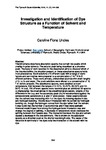Investigation and Identification of Dye Structure as a Function of Solvent and Temperature
| dc.contributor.author | Uncles, C.F. | |
| dc.date.accessioned | 2019-05-22T09:29:46Z | |
| dc.date.available | 2019-05-22T09:29:46Z | |
| dc.date.issued | 2018 | |
| dc.identifier.citation |
Uncles, C.F. (2018) 'Investigation and Identification of Dye Structure as a Function of Solvent and Temperature', The Plymouth Student Scientist, 11(2), p. 244-308. | en_US |
| dc.identifier.issn | 1754-2383 | |
| dc.identifier.uri | http://hdl.handle.net/10026.1/14190 | |
| dc.description.abstract |
Triarylmethane dyes have absorption spectra that contain two peaks which overlap in polar solvents. The second peak being described as a shoulder peak. The body of work recorded in this dissertation aims to discover which of the theories behind the shoulder present on these absorbance spectra holds most precedence. Stock solutions of 5 different dyes with a range of steric factors and symmetries were prepared to a concentration of 10-3 M in 5 different solvents. These were primary, unbranched alcohols with chain lengths of C1 to C4 and water. The stock solutions were diluted to a concentration of 10-5 M, before analysis. The absorbance spectra, were obtained at room temperature, then between the ranges of 0-10°C, 10-20°C, 30-40°C and 40-50°C. In total, 125 different spectra were recorded plus an additional 30 spectra to characterise the uncertainties in the experimental procedure. Graphs of the difference in the λmax and the secondary peak (Δν) in wavenumbers against the solvatochromic parameters α, β and π* were plotted. These graphs indicate that the solvent was interacting with 4 of the dyes via inducing dipoles in dye and hydrogen bonding. Victoria blue R interacted with the solvent by hydrogen bonding too, though the hydrogen comes from the dye rather than the solvent. It was found that the number of auxochromes and if they were sterically hindered would impact how strong the hydrogen bond interaction was and change the degree of splitting. A decrease in temperature would decrease the splitting between the 2 peaks also. The interaction between the dye and solvent causes a decrease in the dye symmetry. This is shown on the absorption spectra as a shoulder peak at the shorter wavelength side. The cause of the reduction in symmetry of the dyes is by the interaction of the solvent with the dye. | en_US |
| dc.language.iso | en | en_US |
| dc.publisher | University of Plymouth | |
| dc.rights | Attribution 3.0 United States | * |
| dc.rights.uri | http://creativecommons.org/licenses/by/3.0/us/ | * |
| dc.subject | Triarylmethane dyes | en_US |
| dc.subject | hydrogen bond interaction | en_US |
| dc.subject | solvent interaction | en_US |
| dc.subject | dye symmetry | en_US |
| dc.title | Investigation and Identification of Dye Structure as a Function of Solvent and Temperature | en_US |
| dc.type | Article | |
| plymouth.issue | 2 | |
| plymouth.volume | 11 | |
| plymouth.journal | The Plymouth Student Scientist |



